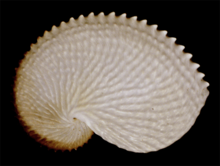Argonauta nodosa
| Knobby Argonaut | |
|---|---|

| |
| Eggcase of Argonauta nodosa | |
| Scientific classification | |
| Domain: | Eukaryota |
| Kingdom: | Animalia |
| Phylum: | Mollusca |
| Class: | Cephalopoda |
| Order: | Octopoda |
| Family: | Argonautidae |
| Genus: | Argonauta |
| Species: | A. nodosa
|
| Binomial name | |
| Argonauta nodosa Lightfoot, 1786
| |
| Synonyms | |
Argonauta nodosa, also known as the knobby or knobbed argonaut, is a species of pelagic octopus. The female of the species, like all argonauts, creates a paper-thin eggcase that coils around the octopus much like the way a nautilus lives in its shell (hence the name paper nautilus). The shell is usually approximately 150 mm in length, although it can exceed 250 mm in exceptional specimens; the world record size is 292.0 mm.[3] A. nodosa produces a very characteristic shell, which is covered in many small nodules on the ridges across the shell, hence the specific epithet nodosa and common name. These nodules are less obvious or even absent in juvenile females, especially those under 5 cm in length.[4] All other argonaut species have smooth ridges across the shell walls.[4]

A. nodosa has a relatively wide distribution covering the Indo-Pacific region as well as the eastern coast of South America. The species is most common in southern Australia, New Zealand, and South Africa.[4] It is only known from the Southern Hemisphere.[6]
A. nodosa is thought to feed primarily on pelagic molluscs. Captive females have been observed readily taking dead prawns and fish.[4] The species is preyed on by numerous predators. It has been reported in the stomach contents of Alepisaurus ferox from the south-western Pacific.[7] A. nodosa has also been found in the stomach contents of Australian fur seals, Arctocephalus pusillus doriferus, in the Bass Strait and southern Tasmania.[8]
Females grow to 100 mm ML and 300 mm total length, while males do not exceed 40 mm in length.[4] The specialised webbed arm pair of this species is covered in numerous chromatophores. Mark Norman notes that "the colour of these webs can quickly change from maroon red to reflective silver".[4]
It has been reported that the egg clusters of A. nodosa from southern Australia can be clearly divided into three portions, each with eggs at a similar developmental stage.[9] Similar development has been observed in the egg masses of Argonauta bottgeri.[10]
A. nodosa is occasionally involved in mass strandings along the South African and southern Australian coastlines. The strandings are seasonal and generally occur between April and August, towards the end of the animals' spawning season.
The type specimen of A. nodosa was collected off the Cape of Good Hope. The type repository is unknown.[11]
-
Female A. nodosa with eggcase removed
-
Female A. nodosa with eggcase present
-
One of the earliest known depictions of A. nodosa, from Index Testarum Conchyliorum (1742) by Niccolò Gualtieri
References
- ^ Allcock, L. (2014). "Argonauta nodosa". The IUCN Red List of Threatened Species. 2014: e.T163029A965050. doi:10.2305/IUCN.UK.2014-3.RLTS.T163029A965050.en. Downloaded on 05 February 2018.
- ^ a b Kirk, T.W. ('1884'). Art. VII.—Description of a new species of paper nautilus (Argonauta gracilis). Transactions and Proceedings of the New Zealand Institute 17: 58–59. (reprint)
- ^ Pisor, D. L. (2005). Registry of World Record Size Shells (4th ed.). Snail's Pace Productions and ConchBooks. p. 12.
- ^ a b c d e f Norman, M. (2000). Cephalopods: A World Guide. ConchBooks. p. 192.
- ^ Sweeney, M.J. (2002). Taxa Associated with the Family Argonautidae Tryon, 1879. Tree of Life Web Project.
- ^ Lu, C. C. "Argonautidae". Australian Biological Resources Study. Retrieved 2006-09-13.[permanent dead link]
- ^ Rancurel, P. (1970). "Les contenus stomacaux d' Alepisaurus ferox dans le sud-ouest Pacifique (Céphalopodes)". Cah. O.R.S.T.O.M. Ser. Océanogr. (in French). 8 (4): 4–87.
- ^ Gales, R. D.; Pemberton, C. C. Lu; M. Clarke (1994). "The cephalopod diet of the Australian fur seal: variation due to location, season and sample type". Aust. J. Mar. Freshwater Res. 44: 657–671. doi:10.1071/MF9930657.
- ^ Reid, A. (1989). "Argonauts: ancient mariners in boats of shell". Aust. Nat. Hist. 22 (12): 580–587.
- ^ Nesis, K. N. (1977). "The biology of paper nautiluses, Argonauta boettgeri and A. hians (Cephalopoda, Octopoda), in the western Pacific and the seas of the East Indian Archipelago". Zool. Zh. 56: 1004–1014.
- ^ Current Classification of Recent Cephalopoda
External links
- "CephBase: Argonauta nodosa". Archived from the original on 2005-08-17.
- Tree of Life web project: Argonauta





